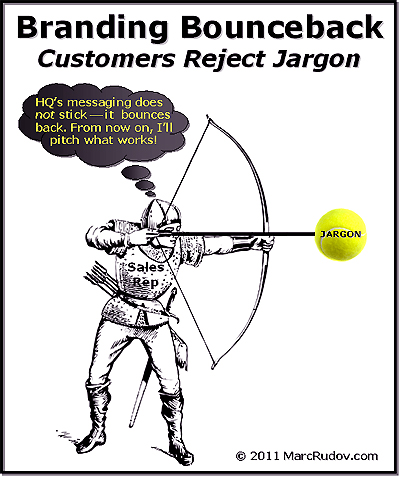You’re an energetic sales rep, armed with product training and imbued with HQ’s brand du jour, sitting before your prospect. When asked to explain your company’s value proposition (brand), you reflexively blurt out the slogan affixed to your company’s homepage: We take you to the cloud. Bewildered, your prospect, neither meteorologist nor balloonist, flashes a blank stare. Bad news: Your pitch just bounced back.
This revenue-killing ordeal is akin to sending an ambiguously worded e-mail: The recipient either ignores it or bounces it back by initiating an exasperating, multiple-volley clarification exercise — ultimately ending in a heated phone call.
Lesson: Failure to hit and stick to your target on the first attempt — in an e-mail, during a sales call, or via a homepage — is an unacceptable, preventable error that carries with it high resource and opportunity costs.
A top salesman succeeds because he knows which words work. He speaks customer-centric language, not vendor-centric jargon. He’ll try the “official” corporate message once; if it fails, he’ll invent his own version. Every other sales rep will do likewise (one brand per sales rep), needlessly boosting the cost of sales, relegating the HQ-articulated brand to the trash.
Jargon, like a tennis ball, is fuzzy and hollow, and bounces off its target. Why? It’s vendor-centric argot; customers reject it. They care only about their agendas, their lingo, and their pressures — not those of suppliers. Despite this, most suppliers are jargon junkies.
Steve W. Martin, who teaches sales strategy at the USC Marshall School of Business, knows that perceiving and leveraging customers’ emotions — garnering GutShare™ — is essential to successful selling. Cerebral selling, consequently, doesn’t work; that’s why mindshare — an absolute waste of shareholder capital — is meaningless and begets bad brands.
Martin penned an article in Harvard Business Review called “Seven Personality Traits of Top Salespeople.” In trait #3, Martin explained the art of selling (emphasis mine):
Top sales performers seek to understand the politics of customer decisionmaking. They strategize about the people they are selling to and how the products they’re selling fit into the organization instead of focusing on the functionality of the products themselves.
Branding Is Macroselling
Selling to one is like branding to many but on a smaller scale, although the skillsets of the people involved are vastly different — unfortunately. Each endeavor requires constructing a detailed map of needs, emotions, politics, and behaviors — and then adeptly incorporating these “coordinates” into customer communications.
Sounds simple, right? Evidently not.
There’s such a disconnect between how top sales reps and homepages (from marketing departments, PR firms, ad agencies, and Web developers) articulate value, resulting from:
- Lack of communications competence (bad now and growing worse): Today’s college graduates — the OMG/LOL/BRB crowd — have no clue how to speak or write;
- Using impotent, consensus-driven committees, which excel at converting arrowheads into tennis balls;
- Aversion to being unique: Most people prefer to blend and imitate;
- Ignorance of human emotions and behaviors;
- CEOs assigning low priority to unique, jargon-free, GutShare-garnering branding.
This value-articulation disconnect explains perfectly why HQ-driven homepages invariably focus on product functionality, feature indecipherable jargon and forgettable slogans, and resemble complex cockpits — the key to bouncing sales.
A top sales rep, alternatively, operates on a completely different wavelength: He relieves the pains and buttresses the ambitions of the execs in the decisionmaking unit — a far cry from “selling products” — by immersing himself in each one’s politics and psyche. Speaking customer-centric language, rarely found on homepages, is paramount to his success.
I’ve asked many sales VPs what role their companies’ homepages play in closing business. Typical reply: It plays no role; my salesforce ignores it, and our customers don’t even look at it. A wasted strategic asset. Are you listening, shareholders?
Rx from the WhiteNoise Doctor™
When your customers and salesforce bounce your homepage, you have a bad brand — one that’s synonymous with ambiguity, complexity, confusion, imitation, and insularity — keeping your company stuck in the white noise, indistinguishable from its competitors.
Does your brand stick or bounce? Quick test: If your top sales reps, who are great proxies for your customers, are pitching with their own arrowheads, it bounces. Getting the point?
© 2011 Marc H. Rudov. All Rights Reserved.
About the Author

Marc Rudov is a branding advisor to CEOs,
producer of MarcRudovTV, and author of four books


